10+ Patent License Agreement Examples
In this fast-paced society, we constantly need improvement and innovation. However, if you have your own inventions, you might be afraid that someone else might copy your idea. To prevent this to happen, a patent system is needed in order to encourage inventors to release their new inventions as keeping innovations secret would actually impede innovation. You may also see management agreement examples & samples.
The government acts to disclose the detail of the invention and issue a patent to the inventor, acknowledging his innovation and securing that the innovation would not be copied by others. Patents could help the inventors in some ways. For example, he could request for money in return for the permission to use his patented asset. Patent licensing then can be a source of income and can be very lucrative business. You may also like business agreement examples.
Patent License Agreement Example
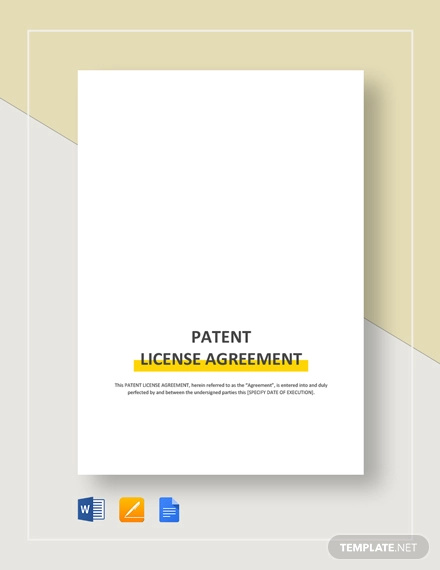
Patent License Agreement Example
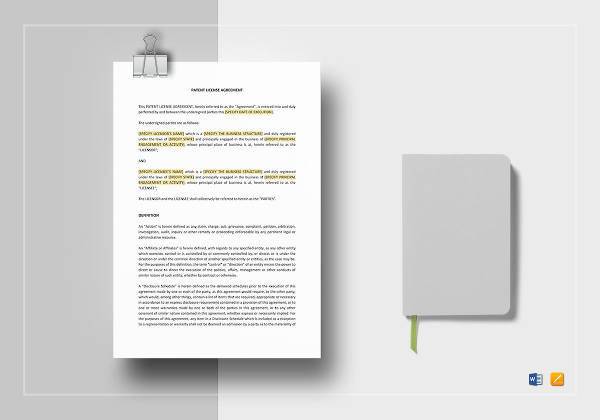
In order to grant other people to use, sell, or make your invention, you need a patent license agreement, the examples of which are presented in the next section.
Clear Patent License Agreement Example
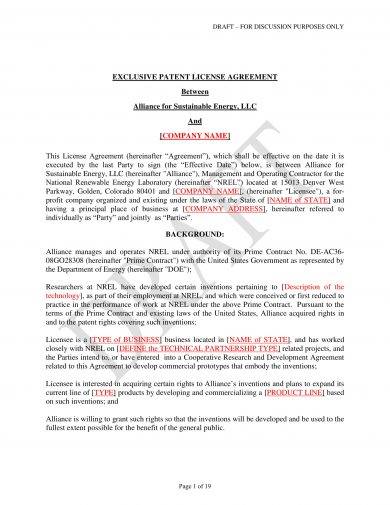
Comprehensive Patent License Agreement Example
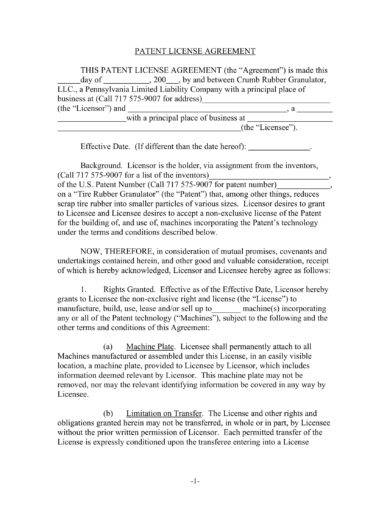
What Is a Patent?
A patent is an exclusive property right that grants the owner/inventor monopoly of said rights for his invention for a limited period of time, preventing others from selling, using, and making the invention. A government entity usually handles patent applications. The validity of a patent would depend on what was being agreed upon; in America, most would last up to 20 years. You may also see letter of agreement examples.
Checklist Sections for Negotiating License Agreements
1. The Parties
Secure the important information to be included in the agreement with regard to the parties such as their names, contact information, and legal address. This information should be exchanged at the first meeting to prevent last-minute phone calls or formal emails.
2. Whereas Clauses
Not all parties use whereas clauses as some would want to make the background information a standard set of clauses that follows a language specifying the terms of the commercial agreement. Here are some whereas clauses:
- Licensor owns certain intellectual property including inventions, patents, applications, and other related use…
- Licensor represents that he or she has the right to grant a license…
- Licensee represents…
- Licensee desires license relating to…
3. Definitions
For simple contracts or agreement, definitions may not be included, as they can be presented when special terms are first encountered. However, in a complex document, definitions should be presented in one section for ease of drafting and later interpreting the general contract. General terms used throughout the contract as well as technical terms that are frequently used should be placed in this section. It is recommended to list them in an alphabetical or a hierarchical order.
Examples of common terms include licensee, sales, net sales, profit, territory, field, patents, patent rights, intellectual property, and nonprofit. Once these terms are already defined, they can appear throughout the rest of the simple contract with the first letter capitalized or in all capitals.
4. The Grant Sections
- Rights granted. The grant language should be specified in the agreement which includes which intellectual property rights the license is given under patent right only or know-how right or both and exclusive right, co-exclusive with the licensor, or nonexclusive. The term of the exclusivity and/or non-exclusivity should also be specified. You may also see service agreement examples.
- License restrictions. In this section, the field, territory, prior licensee’s rights, and the commercial rights retained by the licensor must be specified.
- Reservation of rights. When the licensor is a nonprofit and certain rights to use the intellectual property are reserved for academic, nonprofit research, or humanitarian uses in developing countries, or according to the terms of the Bayh-Dole Act, it must also be included and specified in this section. The agreement can become invalid if this section is missed. You may also like purchase agreement examples.
- Right to grant sublicenses. This portion of the simple agreement must present and specify the grant of a right to grant sublicenses to third parties. Sublicensees can be anyone or may be limited to parties in privity with the licensee, only affiliates of the licensee, only a specified number of third parties, or only parties preapproved by the licensor.
- Territory. You must also be specific with regard to the territory that is granted to the licensee.
- Term of the agreement. The effective date as well as the ending date of the agreement must be noted in the agreement. You may also check out partnership agreement examples & samples.
5. Improvements
In this section, you must specify the improvements made or patented by either the licensor or licensee during the term of the license. The obligations present in the deal as to whether or not to include future technology under the reservation of rights to the licensor must also be included. You might be interested in simple agreement letter examples.
6. Considerations
The items to be listed in this section are the royalty, type of currency, milestone payments, determining rate of exchange, and equity-ownership issues.
7. Reports and Auditing of Accounts
A report should accompany the royalties paid to the licensor as well as on how the royalty was calculated. The due date for these reports must also be clearly stated in the agreement.
8. Representations or Warranties
Basic representations and warranties should be given by each party to the other and must be clearly stated in the agreement. Examples of these representations are the ability to enter into this agreement, the validity of the intellectual property, and a standard warranty disclaimer. You may also see business agreement letter examples.
9. Infringement
In this section, it must present how past infringement by the licensee is handled, how will the recovery of infringement be divided between the licensor and licensee, as well as the indemnification by the licensor of the licensee to practice under the intellectual property rights. You may also like subcontractor agreement examples.
10. Diligence
This section covers the concept that the licensee will do whatever it takes to operate under the license so that the licensor will be benefited under the license to prevent the licensee from exploiting the intellectual property.
Concise Patent License Agreement Example
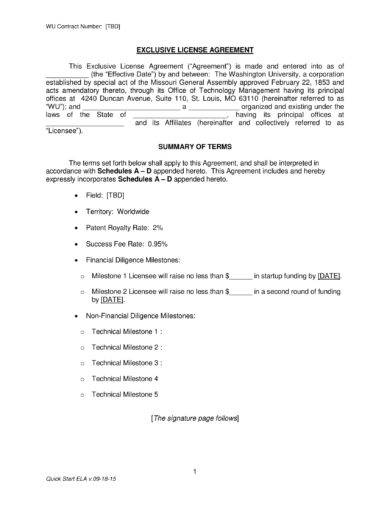
Exclusive Patent License Agreement Example
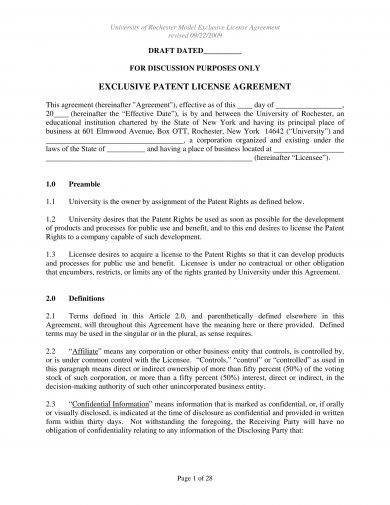
Exclusive Patent License Agreement Template Example
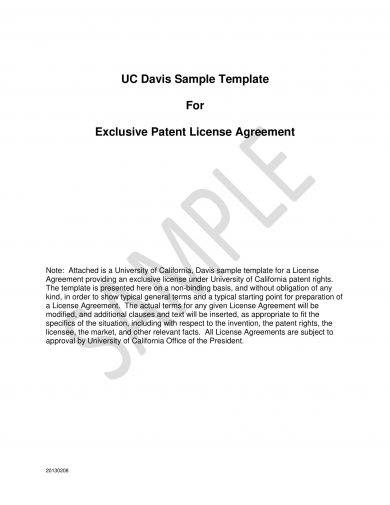
11. Intellectual Property
The intellectual property must be defined in the agreement and how it is paid for. Nonprofit licensors may have more than just a patent to include in the definition of intellectual property.
12. Right of Inspection
The licensee may want to have the right to inspect the licensor’s research data and fields during the term of the license especially if the licensee has licensed seed that is being produced by the licensor and that will include the transfer of that licensed seed to the licensee. You may also check out sales agreement samples.
13. Remaining Sections
The remaining sections are also considered boilerplate sections of the license or standardized sections.
The standard items considered by every licensing professionals include but are not limited to the following: confidentiality terms, provisions for export control, the non-use of each party’s name by the other party, arbitration, terms of breach and the ramifications, force majeure, applicable law, assignment, integration, favored-nation clause, notices, language, modifications, and simple schedules.
14. Confidentiality
If a confidentiality, or nondisclosure, agreement has been entered into by the parties and will remain effective during the term of the license agreement, nothing else is needed.
If this hasn’t been done, a section dealing with terms of confidentiality may be put into the license agreement. If the previously agreed-to confidentiality agreement is weak, now is the time to bolster it and to make sure that these terms in the license agreement take precedence over earlier agreements. You might be interested in contractor agreement examples.
15. Export Regulations
These are important in transactions where technology is exported from the USA as they must comply with US export control laws and regulations and those goods that may have a military use. At times, some or all of the parties do not want their names to be used in connection with any licensed products advertised or sold. In this case, this should be clearly stated in the basic agreement.
16. Arbitration
There are certain cases where there is a major disagreement among the parties with regard to the terms of a standard agreement, and the parties would want to take the issue to arbitration. The rules to be used for arbitration must be stated in the agreement before there is an issue to arbitrate.
17. Termination
You may include in this section the things you can do with the rights of the parties if a material breach happens.
Other areas to consider include the right of either party to end the agreement without any reason, the rights of the party that has performed when confronted with a party that refuses to perform, material breach issues, and the length of notification of breaching activity as well as time given to the breaching party to cure the breach before losing rights or being charged penalties. You may also see agreement letter for payment examples.
18. Force Majeure
Force majeure is defined as unforeseeable circumstances that prevent the fulfillment of a contract. The parties must determine what is required after the force majeure occurs to get the licensed product out the door.
19. Favored Nation
It is hard to determine if one party with a certain royalty has a better deal than another party for similar royalty. Sometimes, the licensee may demand to pay the same royalty to another patent with the same license. The deal with regard to these terms must also be clearly stated in the common agreement.
20. Notices, Integration, Language, Modifications, Law, Signatures
These items must also be clearly stated and specified in one section of the agreement.
- Notices – the handling of any notices or payments that you must make or should receive
- Integration – a statement that this is the controlling document unless specifically stated in the license
- Language – the languages used in writing the license
- Modifications – whether amendments to the license are to be in oral or writing
- Law – the country’s laws to be applied to interpret the license
- Signature – the name and title of the signatory
21. Schedules
In this section, listed are the items covered in the license, background documents, and research project outlines and specific procedures such as the patent list, patent application, description or copies of official documents, accounting procedures, existing licenses or sublicenses, specifics of equity arrangements, research program details. You may also see what is a business agreement?
Exclusive Simple Patent License Agreement Example
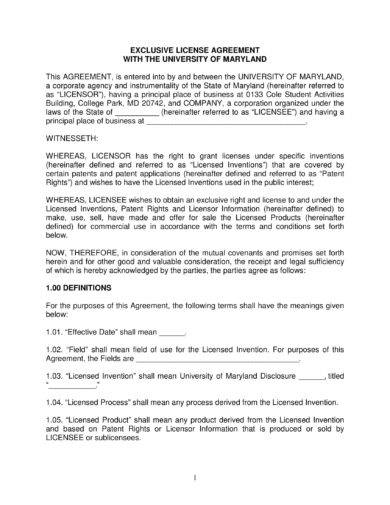
Minimalist Patent License Agreement Example
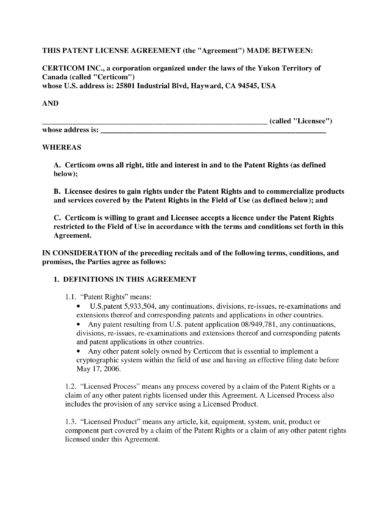
Settlement and Patent License Agreement Example

Software Patent License Agreement Example

Standard Patent License Agreement Example
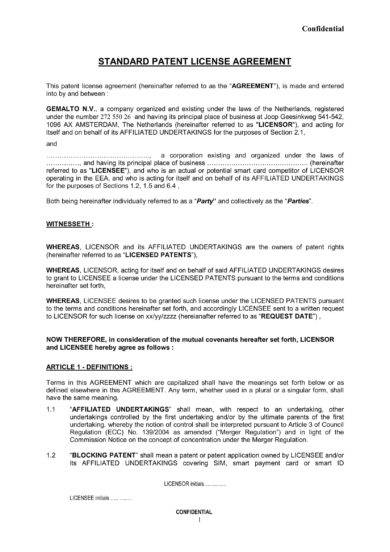
Overall
Patent licensing is needed to protect the ownership right of the inventor and serves to encourage inventors to reveal their inventions without the fear of being copied by other people. The inventors can use their patent license to request payment for people who will use their invention. You may also see professional services agreement examples.
In this way, their ideas and hard work would be paid off. They must have a patent license agreement granting the licensee the right to make, use, or sell the claimed invention in return for a sum of money, a royalty, or other compensation. You may also like how to write a separation agreement.
The checklist for negotiating license agreements are presented in the previous section. Lastly, don’t forget to take a look at the examples of patent license agreements above.


